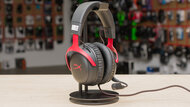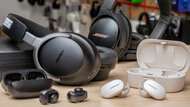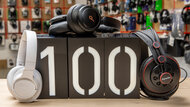- Table of Contents
- Intro
- Review Updates
- Best Headset
- Best Mid-Range
- Best Budget
- Best Bass
- Comparison
- Lineup
- Page Updates
- Conclusion
- Comments

We've tested 16 pairs of HyperX headphones. They mostly make mid-range gaming headsets with a couple of higher-end models. They're known for their great microphones and good overall audio reproduction, but they're generally somewhat lacking in active features and customization options.
Updates
- 03/25/2024 HyperX Cloud Alpha updated
- 10/10/2023 HyperX Cloud III Wireless reviewed
- 09/12/2023 HyperX Cloud III reviewed
- 12/08/2022 HyperX Cloud Stinger 2 reviewed
- 05/09/2022 HyperX Cloud Alpha Wireless reviewed
-
Best HyperX Headset
Sports And Fitness5.9Travel6.3Office Work6.5Wireless Gaming (In Development)7.6Wired Gaming (In Development)6.1Performance Usages: Audio Reproduction Accuracy7.8Noise Isolation4.2Microphone (In Development)7.5Frequency Response Consistency4.9Bass AmountSlightly Underemphasized (-2 dB)Treble AmountSlightly Underemphasized (-3 dB)Sound SignatureWarmType Over-earEnclosure Closed-BackWireless YesTransducer DynamicNoise Cancelling NoMic YesThe best HyperX headset we've tested is the HyperX Cloud III Wireless. These headphones are the next generation of the HyperX Cloud 2/Cloud II Wireless and offer a few improvements. They have a wireless dongle that works with PlayStation and PCs and offers low latency, so your game audio and video stay in sync. Their default sound profile makes instruments and vocals sound clear and natural, though they lack a bit of airy sparkle. At the other end of the spectrum, a little extra punch helps bring out sound effects like footsteps, though rumbly effects could be more visceral and immersive. Happily, and unlike the Cloud II, their companion software offers a graphic EQ and presets for sound customization so you can tweak their sound until it matches your preferences. They also support DTS:X Spatial Sound, which is meant to create a more immersive soundstage, although you have to play a compatible game for it to work.
Their 123-hour continuous battery life is much longer than the previous generation's, so you don't need to recharge your headset daily. The headphones are sturdy and have a comfortable fit that won't cause fatigue for most people, even if you're gaming for hours. Their boom mic has pretty good performance, but if you mostly game online and will use the mic often, you might still prefer the previous generation. The Cloud II's mic makes your voice sound more natural and clear-bodied and has a similar noise-handling performance, so you won't be drowned out by moderate background noise. Unfortunately, both headsets only work wirelessly, so you can't use an analog connection with Xbox or when you're out of battery.
-
Best Mid-Range HyperX Headset
Neutral Sound7.4Commute/Travel4.9Sports/Fitness5.6Office6.2Wireless Gaming5.8Wired Gaming7.7Phone Calls7.2Type Over-earEnclosure Closed-BackWireless NoTransducer DynamicNoise Cancelling NoMic YesCheck out the HyperX Cloud III if you want something more affordable. HyperX released these in 2023 to replace the popular HyperX Cloud 2/Cloud II, which were released in 2015, though the previous generation headphones are still a great option if you can find them in stock. However, if you want the newest product, the III are very comfortable and well-built. Their boom mic does a better job of making your voice sound clearer and more natural than the previous generation but has slightly worse noise handling. However, it's still decent enough to separate your voice from moderately noisy backgrounds.
Overall, their sound profile is balanced, with a detailed mid-range that helps bring out dialogue in cutscenes. However, their bass response is underemphasized across the entire range, so sounds like explosions will lack rumble and boom. Fortunately, unlike the previous iteration, these headphones are compatible with HyperX's NGENUITY software, which lets you modify the sound to your liking. This software is only available on the Windows store; you'll need to sync it to a PC via USB. There are additional controls for adjusting chat and game audio levels and activating a 7.1 virtual surround sound feature. These headphones are also compatible with most consoles via an analog connection.
-
Best Budget HyperX Headset
Neutral Sound7.4Commute/Travel4.7Sports/Fitness5.4Office6.0Wireless Gaming5.3Wired Gaming7.3Phone Calls6.9Type Over-earEnclosure Closed-BackWireless NoTransducer DynamicNoise Cancelling NoMic YesThe HyperX Cloud Stinger 2 are the best HyperX headphones in the budget category we've tested. They're cheap wired headphones with decent gaming performance. However, they aren't as well-built or comfortable as the previous picks. Their boom mic is great but doesn't offer quite the same level of noise handling as the HyperX Cloud III's mic, either. However, it's not an issue if you're gaming in a quiet space, as the mic still captures your voice very clearly. They also have a comfortable fit suitable for long gaming sessions, though the pads aren't as plush as the more expensive models.
Their excited sound profile lends extra punch and boom to your audio, which can help bring out sound effects like footsteps. Elements like voices are clear, present, and bright as well. Like most ΗyperX headsets we've tested, their sound is dependent on the headphones' fit and positioning on your head, so you'll need to adjust them to get the same sound every time you wear them. They lack a companion app to tweak your sound, but our model comes with an activation code for two years of DTS Headphone:X, a spatial audio app that you can use to generate a 3D soundscape for a more immersive gaming experience. It's worth noting that this software only works with Windows 10 and Xbox.
-
Best HyperX Headset For Bass
Neutral Sound7.2Commute/Travel4.9Sports/Fitness5.6Office6.2Wireless Gaming5.7Wired Gaming7.6Phone Calls6.8Type Over-earEnclosure Closed-BackWireless NoTransducer DynamicNoise Cancelling NoMic YesThe HyperX Cloud Alpha S are a great choice if you want to add rumble and thump to your in-game mix. Unlike the HyperX Cloud III Wireless, these comfortable and sturdy headphones have bass sliders on either ear cup so that you can adjust the amount of bass in each separately. With the sliders turned all the way up, they have a boomy sound profile that can help emphasize sound effects like footsteps and explosions in games. They also come with leather or cloth ear cup padding, so you can choose which is more comfortable.
The boom mic has a good performance, so you'll sound natural and easy to understand when gaming with friends, and moderate background noise won't drown out your voice. They're fully compatible with most consoles via analog connection but also come with a USB dongle that provides a low latency connection with PCs and PlayStation consoles. The dongle has physical buttons for volume control, channel mixing, mic mute, and surround sound, so you have some controls within easy reach when gaming. The headphones are compatible with HyperX NGENUITY software, which offers surround sound and microphone level controls but is otherwise simple in design.

Our How We Test Headphones article takes you behind the scenes in our lab. You'll learn how we choose and purchase products and dive into the details of our review philosophy, from testing and scoring to writing and editing.
You can also discover how we produce recommendations like this one, so that you can find the best headphones (or earbuds!) for your needs.
Compared To Other Brands
-
Durable build quality.
HyperX makes sturdy headphones durable enough to withstand constant and repeated use. Even their lower-end models feel like they'll survive getting dropped a couple of times. -
Versatile gaming designs.
HyperX headsets are good not only for gaming but most also have a detachable microphone for more casual use with your mobile devices on the go. None of the models we've tested have an in-line mic for taking calls on your phone, but some have a detachable cable, so any in-line remote will do. -
Great microphone quality.
The microphone quality of most of the HyperX headphones we've tested is excellent. They reproduce your voice accurately and separate noise from speech well enough to use at competitions and in louder environments.
-
Lack active features.
Although HyperX has some wireless headsets and a couple of models that support extra features like surround sound or wireless charging, they don't have headphones that do it all like those that some competing brands offer. -
Few customization options.
Unfortunately, these headphones don't have many customization options, especially compared to gaming headsets from other brands like SteelSeries, Razer, or Logitech.
HyperX vs Logitech
Logitech and HyperX make similarly priced gaming headsets, although HyperX generally produces better-built products. Some are even Xbox compatible, and their mics have better recording quality, too. However, thanks to their companion software support, Logitech's headsets are much more customizable. Some also support Bluetooth, which is uncommon in HyperX headsets, so it's worth considering Logitech's best headsets.
HyperX vs Razer
Razer offers a more diverse lineup of headphones than HyperX, and some of their products are even designed for hybrid casual and gaming use. Some of Razer's best headsets also have features like noise cancelling, haptic bass, or customizable RGB lighting. You can generally expect robust sound customization features, too. Conversely, HyperX may be more barebones regarding extra features, but they produce strictly gaming headphones that are more comfortable and have a better build quality.
HyperX vs Corsair
Corsair and HyperX make many similarly performing headsets at different price points. HyperX headsets tend to be more comfortable, and some of their headphones even come with a second pair of ear cup padding. In comparison, many Corsair headsets have companion app support, which makes them more customizable. A couple of models also support Bluetooth, which is good if you want to stay connected to your console and smartphone simultaneously.
Overall, HyperX makes durable and sturdy gaming headsets at an affordable price with excellent noise-filtering microphones. Most of their headsets are wired, which is great if you prefer to plug and play without worrying about latency, but they also have some good wireless options. However, they lack features like programmable commands and integrated channel mixing, which are present in popular headsets like the Astro A50 X or the SteelSeries Arctis Nova Pro Wireless. Their lineup is worth looking at if you prefer simpler yet well-rounded designs.
It's worth noting that Kingston Technology sold HyperX to HP in 2022. The manufacturer claims that, beyond minor cosmetic differences, the headsets' performance has not changed. While we haven't tested any headsets produced after the acquisition, some users have reported differences in aspects like comfort and sound profile.
Lineup
HyperX offers a few different lineups at different price points with wired and wireless designs. It can be confusing to sort through all of their products, as they all start with 'Cloud,' and many look nearly identical. There's also a distinct 'Cloud' lineup:
- Cloud: A lineup of well-known gaming headsets at different price points. They have an aluminum hinge design and flexible boom mic. Some also come with a USB card.
- Stinger: Mid- to budget-range headsets.
- Flight: Wireless upper mid-range headsets.
- Alpha: High-end headsets.
Recent Updates
-
We've updated the text to align it with our latest test bench results but haven't changed our picks.
-
We've checked this article for accuracy and product availability but there hasn't been a change in our recommendations.
-
Oct 01, 2024 : We made small changes to the text for consistency but haven't changed our picks.
-
Jul 05, 2024 : We replaced the HyperX Cloud Stinger S with the HyperX Cloud Stinger 2 since the Stinger S are only intermittently available. Other than that, we just made a few small edits to the text for clarity.
-
Apr 09, 2024 : We've replaced the HyperX Cloud Stinger with the Cloud Stinger S, as the original Stinger are no longer available.
Conclusion
HyperX makes mostly wired gaming headsets with excellent microphones and sturdy build quality. They're affordable and sound moderately well-balanced, and their wired models offer a great low-latency gaming experience. Not everyone finds a wired design as convenient, though. Their headsets also lack customization options compared to other brands.
Test Results
Comments
Best HyperX Headphones: Main Discussion
What do you think of our picks? Let us know below.
Looking for a personalized buying recommendation from the RTINGS.com experts? Insiders have direct access to buying advice on our insider forum.
Update: We’ve updated the text to align it with our latest test bench results but haven’t changed our picks.
What do you think of these changes? Let us know
- 21010
Sorry, I was referring to best mid-range and bass which are both wired and perform worse in your results. I couldn’t care less about wireless but others may so I can understand that being a top pick.
Thanks for your follow-up comment and clarification.
The HyperX Cloud Alpha S have a bit more boom and punch out of the box than the HyperX Cloud Alpha, which is why they’re our bass pick. We think bass fans will appreciate the extra warmth, even if it isn’t closely aligned with our target curve.
The HyperX Cloud III come with a companion app which allows you to tweak the sound to your liking, and also adjust some basic mic controls. They also support DTS:X Spatial Sound, for gamers who like very wide soundstages. We think most users would prefer the benefit of those additional features to the slightly flatter default sound of the HyperX Cloud Alpha, but if a flat sound is important to you, the Cloud Alpha are a good choice!
I hope this helps!
- 21010
Thanks for your question. We agree that the HyperX Cloud Alpha are a solid choice, especially if you’re happy to use wired headphones. In general, they’re very comparable to the HyperX Cloud III Wireless, but we think many gamers would prefer the flexibility of the wireless connection the Cloud III Wireless provides. The Cloud III also come with a companion app that lets you customize their sound to your liking, which adds to their versatility. I hope this helps. Thanks!
Sorry, I was referring to best mid-range and bass which are both wired and perform worse in your results. I couldn’t care less about wireless but others may so I can understand that being a top pick.
- 21010
Huh? Shouldn’t the Alpha Non-S be the best? Sure they don’t make them anymore but they aren’t too hard to find brand new still.
Thanks for your question.
We agree that the HyperX Cloud Alpha are a solid choice, especially if you’re happy to use wired headphones. In general, they’re very comparable to the HyperX Cloud III Wireless, but we think many gamers would prefer the flexibility of the wireless connection the Cloud III Wireless provides. The Cloud III also come with a companion app that lets you customize their sound to your liking, which adds to their versatility.
I hope this helps. Thanks!
- 21010
Huh? Shouldn’t the Alpha Non-S be the best? Sure they don’t make them anymore but they aren’t too hard to find brand new still.
Update: We made small changes to the text for consistency but haven’t changed our picks.
What do you think of these changes? Let us know
- 21010
Problem with all Hyper x products and perhaps the world itself is that I use the product and about 1 year later, the leather on the pads flakes, a bit later the headband goes, a bit later the finish on the plastic becomes disgusting, etc. These things do not happen with Razer pads and headbands from my experience.
Hey there,
Unfortunately, things like ear pads and headband cushions tend to fall apart first with most headphones, and that’s just part of wear and tear. Arguably though, some companies invest in more durable leatherette fabrics and plastics than others, but also mileage can vary because these react to your particular skin chemistry. This might seem like an odd comparison, but I’ve had many pairs of plastic glasses that degrade over time because of my skin chemistry (apparently, this is normal), and that’s part of the reality of different plastics interacting long-term with a specific body chemistry because some people wear the same frames for years and years without the plastic looking worse for wear, but not me! It’s kind of a similar issue with the plastic and leatherette fabric on headphone pads, so giving them a quick wipe down now and then can slow the degradation, but it’s not going to stop it entirely.
That said, I’m pretty sure you can replace the ear pads for most HyperX headsets; they should just pull off. Replacing the headband padding is another matter, though. While some industrious folks can probably disassemble and replace the padding with an aftermarket solution, the rest of us are better off using a replaceable headband wrap if the headband’s padding starts to degrade. Or, as you say, go with a different brand if this is a chronic issue. Cheers!































































































